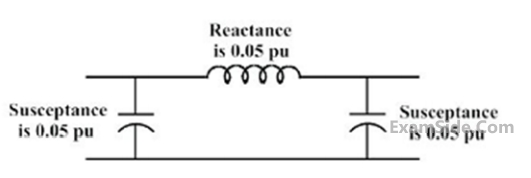1
GATE EE 2018
MCQ (Single Correct Answer)
+2
-0.67
The per-unit power output of a salient-pole generator which is connected to an infinite bus,
is given by the expression, P = 1.4 sin $$\delta $$ + 0.15 sin 2$$\delta $$, where $$\delta $$ is the load angle. Newton-Raphson method is used to calculate the value of $$\delta $$ for P = 0.8 pu. If the initial guess is
$$30^\circ $$, then its value (in degree) at the end of the first iteration is
2
GATE EE 2017 Set 1
MCQ (Single Correct Answer)
+2
-0.6
The bus admittance matrix for a power system network is
$$$\left[ {\matrix{
{ - j39.9} & {j20} & {j20} \cr
{j20} & { - j39.9} & {j20} \cr
{j20} & {j20} & { - j39.9} \cr
} } \right]\,pu.$$$
There is a transmission line connected between buses $$1$$ and $$3,$$ which is represented by the circuit shown in figure.
There is a transmission line connected between buses $$1$$ and $$3,$$ which is represented by the circuit shown in figure.

If this transmission line is removed from service what is the modified bus admittance matrix?
3
GATE EE 2015 Set 1
MCQ (Single Correct Answer)
+2
-0.6
Determine the correctness or otherwise of the following Assertion (a) and the Reason (R).
Assertion (A): Fast decoupled load flow method gives approximate load flow solution because it uses several assumptions.
Reason (R): Accuracy depends on the power mismatch vector tolerance.
Assertion (A): Fast decoupled load flow method gives approximate load flow solution because it uses several assumptions.
Reason (R): Accuracy depends on the power mismatch vector tolerance.
4
GATE EE 2013
MCQ (Single Correct Answer)
+2
-0.6
In the following network, the voltage magnitudes at all buses are equal to $$1$$ p.u., the voltage phase angles are very small, and the line resistance are negligible. All the line reactances are equal to $$j1\Omega .$$


The voltage phase angles in rad at buses $$2$$ and $$3$$ are
Questions Asked from Load Flow Studies (Marks 2)
Number in Brackets after Paper Indicates No. of Questions
GATE EE Subjects
Electric Circuits
Electromagnetic Fields
Signals and Systems
Electrical Machines
Engineering Mathematics
General Aptitude
Power System Analysis
Electrical and Electronics Measurement
Analog Electronics
Control Systems
Power Electronics